White Dexter Color Genetics
White Dexters are typically characterized by their striking white color and black points. As the breed has grown, the ways in which the color patterns passed remained somewhat elusive. Fast forward to June of 2022, and we now have a test available that identifies the White Color variant! The test will determine the number of copies of the White variant any given animal possesses. This will give every breeder an accurate method to plan and select animals to meet their goals. We are extremely excited to be able to release this information! Breeders can access this test here.
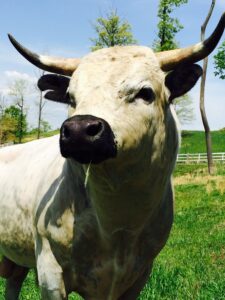
How is the White Color created?
The white color in our Dexters is created through a variant in chromosomal sequencing. The variant is dominant, meaning if the animal has at least one copy of the White Dexter Pattern (WDP) gene, the animal will show white (sometimes in varying degrees). White Dexters can have either one or two copies of the WDP gene, which testing will show. The offspring will show coloring based on how many WDP copies the parents have and how many are passed to the offspring.
How is the White Color passed?
Each White Dexter is either heterozygous (hetero-) White (Wn) or homozygous (homo-) White (WW). The hetero- White Dexter has one of the WDP copies and will typically be white (sometimes in varying degrees). You can expect a hetero- White Dexter to have strong black points at the nose, eyes, ears and lower legs along with varying degrees of roan or spotting on the torso. The remaining traditional color gene in a hetero- White Dexter is still determined by, and can be tested, in a typical fashion. A homo- White Dexter has two WDP copies, will be white, and typically have limited point markings on the eyes, ears, nose and legs and very little, if any, torso spotting or extra color. A homo-White Dexter will produce 100% offspring containing at least one copy of the WDP gene (hetero- White) when bred to another Dexter. (We cannot guarantee that a homo- White Dexter will always transfer the white color when bred to other breeds.) Breeding Stock animals (solid color) are ones in which two non-white genes were passed to the offspring (nn), and they will not be white in color. Breeding Stock do not have a copy of the WDP; therefore, they cannot pass any white color to their offspring. Breeding Stock are intended to be used in White Dexter breeding programs with other White Dexters that carry the WDP copy.
Diagrams for White Dexter Breedings
Now that we have the ability to tell how many copies of the WDP (White Dexter Pattern) each animal carries, this will help breeders know better what to expect from each cross of tested animals. The charts below give you specific percentages of what breeders can expect based on the color status of the two parents.
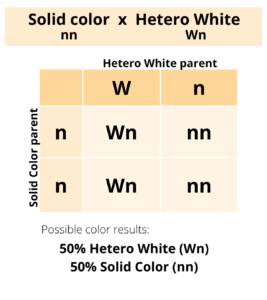
This is the typical cross we have expected in the past: a White animal crossed with a solid colored animal with 50% White outcome.
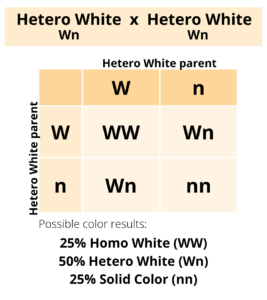
This is the typical White to White cross. It shows the percentage of producing a homo- White animal as well as the percentage for producing a solid color offspring.
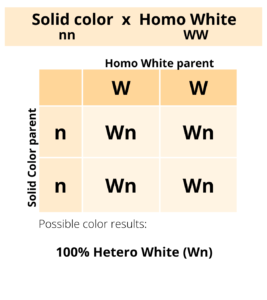
A homo- White Dexter crossed with any solid color Dexter will produce 100% offspring carrying a copy of the WDP gene! This is the ideal way for breeders with a traditional herd to guarantee 100% hetero- White offspring in the first year.
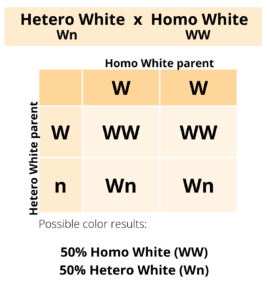
This would be an ideal White to White cross wherein all offspring will carry at least one copy of the WDP, with 50% being homo- White.
What Does This Mean?
This information allows breeders to more accurately plan their breeding strategies with more reliable outcomes. We have known homo- White Dexters are out there, but unless a potential homo- White bull was bred to seven solid colored females to test if every offspring came out white, it was impossible to know. And we simply could not know the White status of females. This testing opens up a whole new chapter for the White Dexter breed, and we are thrilled to be able to share it with you!
If you have any questions, please direct them to registrar@whitedexter.com.
A huge thank you goes to the scientists at Texas A&M for the development of this testing. Please be prepared for an influx of testing at the beginning and possible long wait times for results. We will update this page with any new information, if necessary, as we receive it.